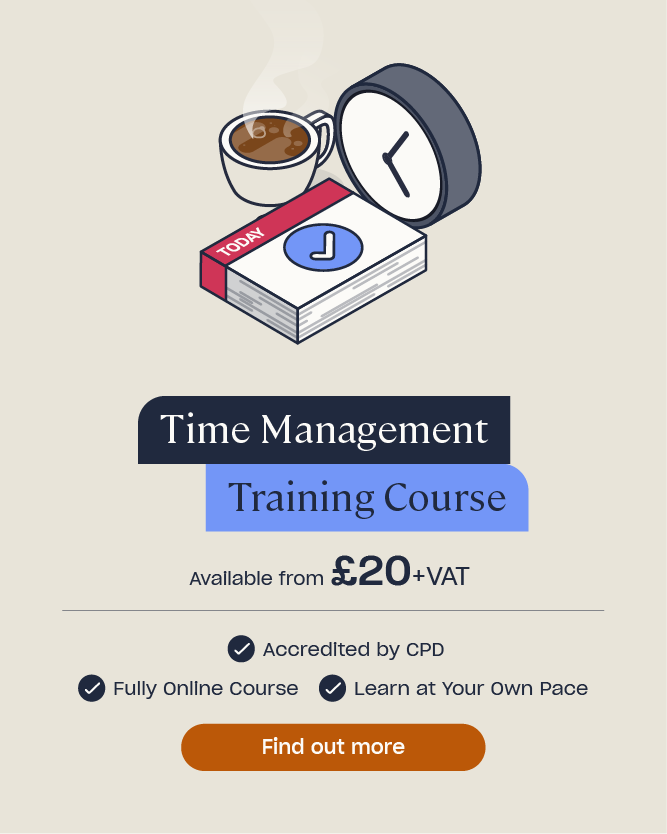Time Management Matrix – Free Template
What is a Time Management Matrix?
Stephen Covey’s Time Management Matrix is simply a grid that classifies your tasks into 4 categories:
- Urgent and important.
- Urgent, but not important.
- Not urgent, but important.
- Neither urgent nor important.
The aim is to re-evaluate tasks that need to be done and free up time to focus on priorities.

To use the Time Management Matrix, download the table below and then write each of your tasks in an area of the grid depending on how you would classify their urgency and importance.
Write down all of your daily or weekly tasks and then have a go at placing them in the grid according to the 4 categories. This will help you re-order tasks and delegate tasks to others in order to improve your time management skills.
Categorising Tasks
Important and Urgent Tasks (Quadrant 1) – these are the tasks you cannot avoid and must get done, often at the last minute and to a tight deadline because you have put them to one side due to poor time management. These tasks have suddenly become ‘urgent’ and now cannot be completed at leisure. The aim is to try and avoid tasks from being in this box on the grid. Such tasks include crises, due deadlines on a project and health emergencies.
Important but Not Urgent Tasks (Quadrant 2) – these tasks are the ones that will help you to achieve your aims and ensure important work gets done. They are not urgent because you have enough allocated time to get them completed, but they are essential to the success of the personal or professional goal. You should aim to invest the majority of your time on this quadrant. Such tasks include planning, prevention and relationship building.
Not Important but Urgent Tasks (Quadrant 3) – these tasks are ones that will prevent you from achieving your aims. They are often done at the last minute and take up a great deal of time, but are of no significance to your goal. These tasks are ones you can delegate to other people so you can concentrate fully on your important tasks. Such tasks include an incoming phone call, emails and interruptions.
Not Important and Not Urgent Tasks (Quadrant 4) – these tasks should be avoided where possible, as they are the tasks that simply waste time. Try to have no tasks in this grid of your Time Management Matrix and, if you do, try to work out how you can eliminate them. However, they do offer a work-life balance and downtime, but should be put at the bottom of the priority list. These tasks include daydreaming, watching TV and trivial busy work.
Need a Course?
Our Time Management Training teaches you all the skills you need to achieve this and organise your time effectively. You will learn how to manage your time and use your initiative to benefit both your work life and personal life.
Why Implement a Time Management Matrix?
The matrix helps you use your time effectively and efficiently. It will help you to avoid spending too much time doing unnecessary or unimportant tasks. The strength of the matrix is that it helps you prioritise your tasks and activities in a very clear way. This allows you to decide which are most important and which are urgent. However, most people stay stuck in quadrant 1. In order to realise your goals, you must focus on quadrant 2.
To boost productivity, you should live your life in the upper half of the quadrant, dedicating most of your time to quadrant 2 but completing tasks in quadrant 1 to get by. You should only use quadrant 4 as part of your downtime. One approach of using the Time Management Matrix is not necessarily better than another: some people complete the quadrant 1 tasks first before quadrant 2, whilst others do the opposite.
How Can it Assist You?
Implementing the matrix will make you more aware of your daily tasks and how you can get past them to achieve your goals. They’re easy to start; all you require is a pen and some paper. Once it is written down, you will begin to realise that you may be spending a lot of time in quadrant 4. These mindless tasks – such as daydreaming, net surfing and chatting – serve no purpose towards your professional development.
Once you have implemented the Time Management Matrix, you should make sure you review your goals regularly and re-prioritise tasks appropriately, whilst adding in any other activities you are completing that weren’t on the list before.
If you find yourself completing more and more mindless unhelpful tasks that belong in quadrant 4, review your matrix regularly. It will help you stay on top of your time management and make the most of your working time.
Further Resources:
- One Week Time Management Plan: Three Famous Techniques
- How to Increase Productivity in the Workplace
- Time Management Course




